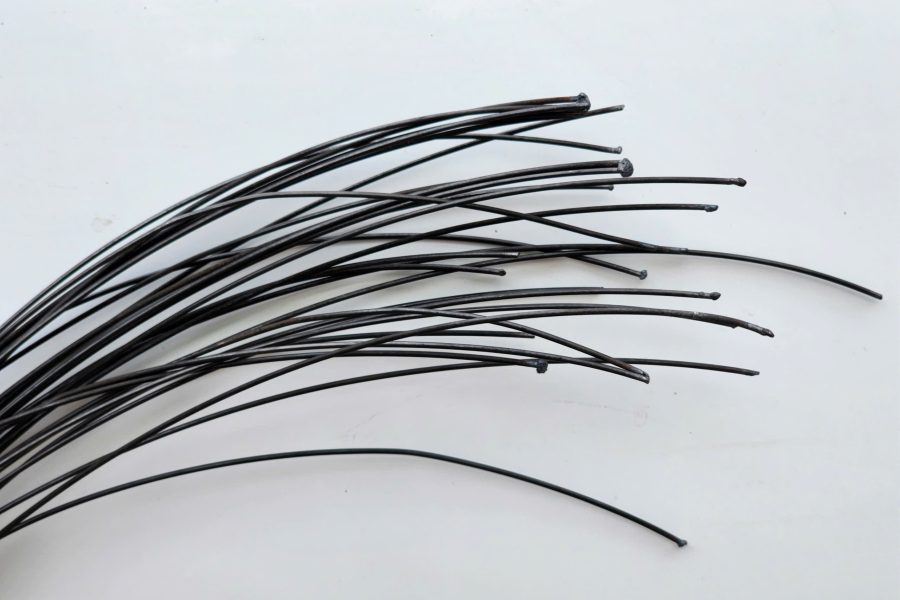Can be recycled into new metal products, supporting the circular production model and infrastructure construction.
Output: 37,400 tons/year
Steel Wire – a recycled material from tire pyrolysis, supports the production of new metal, contributes to infrastructure construction, and promotes the circular economy model.

Detailed Description:
1. General Introduction
Steel wire is the metal core recovered from waste tires through pyrolysis technology. It is a high-value product for the metallurgical and construction industries, as it retains the strong structure of carbon steel after the treatment process. Not only does it help maximize the use of available resources, but steel wire is also a crucial component of the circular production model, where waste becomes a raw material for a new production cycle. With an output of 37,400 tons/year, the steel wire supplied by IMES is being consumed by many metallurgical plants and construction units, helping to reduce the pressure on resource extraction and protect the environment.

2. Origin and Recycling Process of Steel Wire
Steel wire is recovered during the tire pyrolysis process – an advanced technology for treating rubber waste in an anaerobic condition. When tires are pyrolyzed at high temperatures (350–500°C), organic components like rubber and polymer fibers decompose into pyrolysis oil and carbon black, while the steel wire core is separated and cleaned. After recovery, the steel wire will be:
- Cleaned of impurities, carbon dust, and residual rubber.
- Baled or packaged as required for convenient transportation and recycling.
- Sent to metallurgical plants for melting and reuse as a new production material, such as: construction steel, mechanical components, steel mesh, cold-drawn steel wire, etc.
3. Key Features of IMES Steel Wire
- High Quality: The recovered steel wire maintains stable mechanical properties, high carbon content, and good tensile strength.
- Clean, Low Impurity: The product is cleaned to minimize residual carbon black and rubber, making it suitable for metallurgical recycling.
- Easy to Transport and Store: Can be baled, bagged, or supplied in loose form depending on the customer’s needs.
- Saves Raw Material Costs: Compared to virgin steel, steel wire has a lower cost, helping businesses optimize production costs.
4. Practical Applications of Steel Wire
4.1. Metallurgy and Steel Production
Steel wire is an ideal raw material to:
- Be remelted into steel billets, used in the production of construction iron, steel plates, steel pipes, etc.
- Produce alloy steel or industrial components through melting, impurity filtration, and casting processes.
4.2. Mechanical and Consumer Products
After processing, steel wire can be used in:
- The production of binding wire, steel mesh, springs, or cold-drawn steel wire.
- The fabrication of small machine parts, hand tools, or auxiliary equipment in the agricultural sector.

4.3. Construction and Infrastructure
Steel wire is used to:
- Produce concrete reinforcing steel and support materials in civil and industrial construction.
- Promote a circular economy in construction, thanks to its high recyclability and reduced dependence on virgin steel.
5. The Role of Steel Wire in the Circular Economy Model
The circular economy is an inevitable development trend aimed at optimizing resources and reducing environmental emissions. In the industrial waste treatment cycle, steel wire is a prime example of the ability to reuse waste as new raw material. IMES, as a supplier and trader of steel wire, has contributed to:
- Reducing the volume of landfill waste by fully utilizing waste from tires.
- Conserving mineral resources (iron ore, coking coal, limestone, etc.).
- Reducing CO₂ emissions in the steel supply chain by using recycled steel.
6. Environmental and Economic Benefits
- Environmental:
- Reduces pollution from rubber waste.
- Saves energy and water compared to steel production from ore.
- Limits greenhouse gas emissions.
- Economic:
- Reduces input material costs for metallurgical and construction businesses.
- Creates additional revenue from waste for waste treatment units.
- Contributes to the development of the domestic recycling value chain.
7. Reference Technical Specifications (may be adjusted per batch)
- Steel Type: Low to medium carbon steel (depending on tire source).
- Fiber Size: 1–2 mm (twisted round form).
- Carbon Content: 0.4–0.8%
- Remaining Impurities: ≤ 3%
- Packaging: 800–1,000 kg jumbo bags or pressed bales.
With a stable output of 37,400 tons/year, steel wire is not just recycled scrap but a high-value secondary resource. As an integral part of the product chain from rubber and plastic waste pyrolysis, the steel wire supplied by IMES helps promote green industrial production, save costs, and actively contribute to sustainable development goals.

